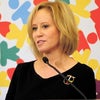“We must think differently, look at things in a different way,” the late Israeli leader Yitzhak Rabin once said. “Peace requires a world of new concepts, new definitions.”
Rabin’s wisdom has always rung true, but it feels especially relevant today, at a moment when the prospects for peace between Israelis and Palestinians appear to be dwindling.
On Wednesday, Israeli Prime Minister Benjamin Netanyahu will visit the White House for the first time since the end of the Obama administration. He is expected to receive a warm welcome from President Trump, who has sharply criticized Obama’s approach to the Israeli-Palestinian conflict. But the president’s friendship may come at a cost: since his inauguration, Trump’s posture has led some in Israel’s government to push for the expansion of settlements in the West Bank that are widely seen as an obstacle to peace.
Settlement expansion, considered illegal under international law, has always been controversial. Yet the discussion of settlements—and the Israeli-Palestinian conflict more broadly—often gets oversimplified and pushed to the extremes: settlements are alternately portrayed as the greatest obstacle to a two-state solution or not a problem at all; Palestinians are either innocent victims or committed to Israel’s destruction. There’s little room for nuance, almost no common ground.
This kind of zero-sum conversation may serve particular political agendas, but it doesn’t serve Israelis or Palestinians who live their lives under the shadow of perpetual conflict. In some cases, it merely deepens their feelings of social isolation in a world that often seems to discount their humanity. Rather than accepting these counterproductive arguments, it’s time for all of us to “look at things in a different way,” as Rabin said, and to recognize that the path to peace lies in the shared humanity that connects people on both sides of the conflict.
Look at it, for example, through the eyes of a Palestinian child.
Imagine being afraid to play outside because there are soldiers with guns monitoring your every move. Imagine watching other kids your age ride their bicycles down streets where you’re not allowed to go but not understanding why. Or imagine knowing that every time your parents leave home, they might not return until late because they could get stuck at a security checkpoint where they’re forced to endure aggressive questioning and humiliation.
When the Israeli government demolishes a Palestinian home in order to expand a settlement, it sends a message to Palestinian families that their homes—a source of pride, a setting for hospitality, and sacred to their sense of community—are worth nothing. The isolation is both physical and psychological.
Now, look at it from the perspective of an Israeli child.
Imagine growing up in a neighborhood where the only place it’s safe to play is an indoor playground that is also a bomb shelter. Or imagine knowing that when you turn 18, you’ll be required to put your hopes and dreams on hold to spend three years in the military defending your country from the same threats your grandparents fought against decades earlier.
And when Israelis are born or move into housing in the West Bank, whether for religious reasons or simply because it’s more affordable, they are condemned by millions of people around the world in a way that can seem like an attack on their very existence. Their isolation, too, is real and lasting.
Though we often hear about a “cycle of violence,” the conflict also perpetuates a cycle of isolation that makes it harder to find common ground. Fortunately, there are also a variety of inspiring initiatives helping Israelis and Palestinians rediscover their shared humanity.
Take the grassroots organization Mahapach-Taghir, which brings together Jewish and Arab women who aim to create social change through education. According to Muna Arok, a Muslim Palestinian-Israeli featured in a video about the organization’s work, it helped her realize that Jewish women’s “worries are similar to ours.” Anat Bracha, a Jewish Israeli, said, “It gives us, all of us, an understanding that we have a place here.”
Another group that cultivates a sense of social connectedness is Combatants for Peace, a nonviolent grassroots organization that unites former Israeli and Palestinian combatants. The group was cofounded by Bassam Aramin, a Palestinian who was imprisoned for seven years after planning an attack on Israeli soldiers when he was 17 years old. After forming an unlikely friendship with his Israeli prison guard, Aramin began to understand how Israelis and Palestinians saw each other in similar ways. In 2005, he created Combatants for Peace, which defines itself in part as a “community” devoted to “changing attitudes on a wide scale.”
Today, there are a growing number of groups offering an antidote to the social isolation that so many Israelis and Palestinians experience. Roots brings Israeli settlers and Palestinians together to transform both societies through trust and empathy. The Parents Circle Families Forum, which consists of some 600 families, brings together Israelis and Palestinians who have lost loved ones to violence to advocate for a peaceful resolution to the conflict—recognizing that a Jewish mother’s tears are no different from a Palestinian mother’s tears.
While it’s natural these days to read the news and despair, the enduring truth of humanity is that we have more in common with those around us than we do not. There are Israelis, Palestinians, and many others around the world who are invested in moving toward a society where we not only “think of others,” as the Palestinian poet Mahmoud Darwish wrote—we embrace them. If we follow their lead, peace may be possible sooner than we think.
